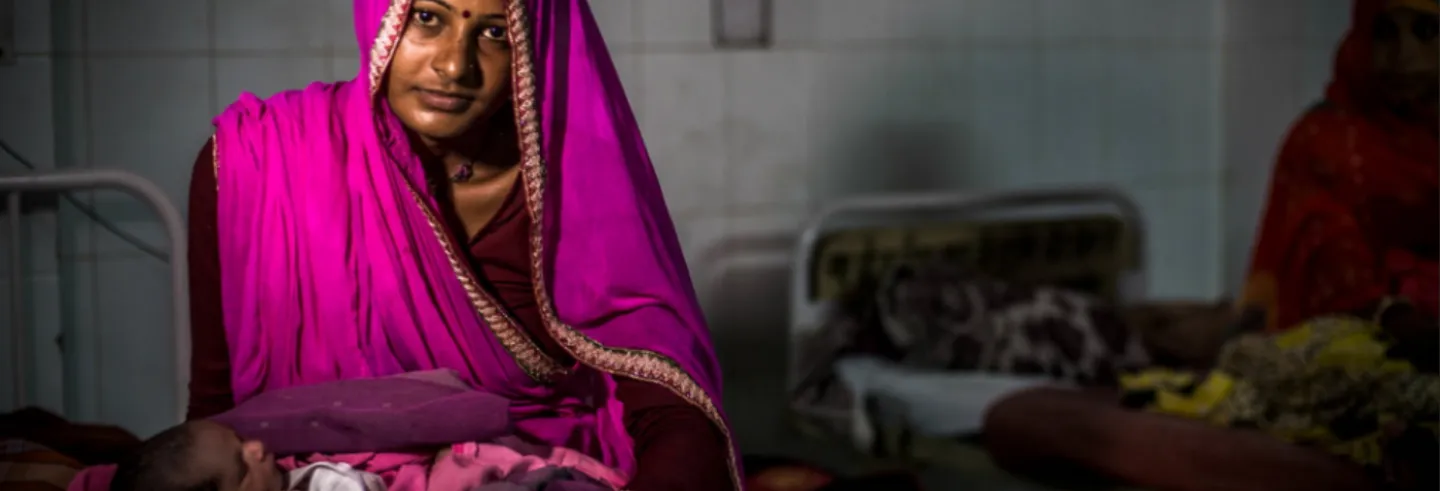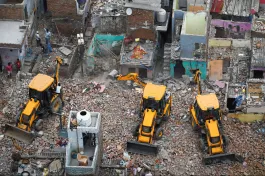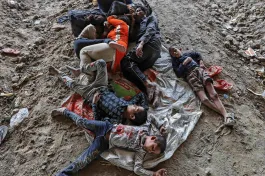Introduction
The National Rural Health Mission (NRHM), which was launched in 2005, focused on reducing maternal mortality in India, among other lofty goals. Emphasising institutional obstetric care, the NRHM incentivised village-level accredited social health activists (ASHAs) to bring women to primary health centres (PHCs) and offered families conditional cash transfers and free ambulance services. In institutions, doctors trained in Indian systems of medicine and staff nurses were reoriented and deployed for obstetric care.
The strategy seemed to work. The proportion of institutional deliveries doubled from 38.7% in 2005-06 (IIPS 2007) to 78.9% in 2015-16 (IIPS 2017). And the country’s maternal mortality ratio, which captures the risk associated with each pregnancy, fell from 280 in 2005 to 174 in 2015 (WHO 2015). While statistics pointed to a success story, women’s health advocates and public health researchers like me offered a more muted narrative.
Our work with poor or disadvantaged populations in the country told us that women were continuing to die when they could have been saved; that obstetric practices and health provider behaviour could be egregious, adverse, and even violent. Our evidence mirrored and gave new meaning to what was termed “obstetric violence” in Latin America, “disrespect and abuse” or “mistreatment” elsewhere.
Is gender, as it is intersected by other socio-economic inequalities (for example, caste, economic class), a factor driving how people-centred health systems respond to maternal health needs and rights?
Global advocacy for respectful maternity care began in 2010. The World Health Organisation followed by issuing a statement calling for the prevention and elimination of disrespect and abuse during child birth in 2014. It also put forth a set of guidelines on women-centred obstetric care in 2016. India’s response in 2017 was LaQshya—a quality of care initiative aimed at improving labour rooms and maternal operation theatres in public health facilities. But emerging evidence suggests that respectful maternity care, the most challenging element of LaQshya, has been slow to get going.
Why do maternal health programmes go so far but no further? Is gender, as it is intersected by other socio-economic inequalities (for example, caste, economic class), a factor driving how people-centred health systems respond to maternal health needs and rights?
To answer these questions, I draw upon verbal autopsies of maternal deaths conducted as part of a research project on maternal safety and rights in Koppal district in Karnataka. Our autopsies were in-depth explorations of the forces driving women to tragic deaths and the actions that could have saved them. The methodology recognised and tackled the subjectivities embedded in memories of a deceased person and the events leading to her death by triangulating the narratives of all key eyewitnesses with clinical evidence.
The ultimate goal was to identify the time points at which she could have been saved, contrasting required actions with those actually taken, and classifying failures as “non-actions”, “inadequate actions”, “inappropriate actions” and ”unavoidably delayed actions” (Iyer et al. 2013). Between 2008 and 2014, 78 deaths were investigated using this methodology. Each autopsy revealed how gender, caste, and economic class operating within homes, communities, and a constrained public health system contributed to each death.
Gendered pathways
At the heart of maternal health lie gender power relations that are sustained by norms prescribing how women and their families should think and act in matters related to reproduction. But gender relations are fine-tuned by caste, economic class, affiliation to a tribal group, and so on. For example, the notion of family honour in dominant caste families can restrict women’s mobility and social interactions far more than it does lower down the caste hierarchy. Or gender-biased rationing of resources in poor households can curtail women’s access to healthcare, but less so in non-poor households.
Case studies illustrate how intersectional gender power relations mediate maternal health outcomes through five pathways.
• Inadequate awareness of health needs among women and their families, which leads to a tendency to normalise adverse health conditions (for instance, chronic weakness) and overlook the need for care. Disempowerment can also leave women/families with a diminished sense of their rights and entitlements in health institutions.
• Inadequate acknowledgement of women’s health needs in health institutions (George et al. 2005). Health needs can get invalidated altogether due to an explicit gender bias. Or the severity of highly prevalent health needs can go unrecognised. Health needs may be recognised but ignored due to other issues claiming priority or due to the lack of time in overcrowded facilities.
• Inadequate access to the tangible and intangible resources (for instance, money, time, labour substitutes, social networks, and so on) required to obtain maternal healthcare, especially during obstetric emergencies, which can be extremely tenuous when gender relations are adverse.
• Inadequate accountability of families and health providers for maternal safety though it is their responsibility to uphold the needs and rights of childbearing women. Accountability can be subverted by intersectional gender power.
• Quality of care going beyond the physical layout of labour rooms, which includes routine obstetric practices and interpersonal communications that prioritise women’s best interests and steer them clear of harm. Altering established practices and hierarchical modes of communication that emanate from gender inequality are big challenges for health systems.
The role and relative importance of each pathway altered quite dramatically after the NRHM was rolled out in Koppal in 2009.
Factors driving preventable deaths
Verbal autopsies conducted before the NRHM revealed that women and/or their families approached several providers in the lead up to obstetric emergencies but their health needs were often unacknowledged or poorly treated in a fragmented, uncoordinated health system (George 2007). Health providers could also be negligent or discriminatory, especially if the women were poor, lower caste, or otherwise disadvantaged.
Obstetric emergencies culminating in deaths were not monitored by the public health system and often went unnoticed even in village communities that are segregated along caste lines. These gendered pathways were evident in the pregnancies that tragically ended the lives of Laxmi and Rani in 2008.
Laxmi (Laxmi, Rani, Durga, and Ratna are pseudonyms), a lower caste casual wage labourer living in poverty, got pregnant for a third time, hoping to give birth to a son. She was malnourished, which left her with little energy or stamina. Her advancing pregnancy worsened her anaemia, leaving her breathless while she worked. Severe headaches with giddiness and blurred vision (due to hypertension) also set in.
After childbirth at the PHC, Laxmi began to bleed uncontrollably, which necessitated a referral to the taluk hospital ... The transfer took three hours as her family had to mobilise funds and arrange for transport.
When headaches prevented her from doing the housework, her husband turned violent. Laxmi received three antenatal check-ups at the PHC but no meaningful treatment for anaemia even though the doctor considered her weak. Her hypertension remained unacknowledged and untreated as well.
Laxmi moved to her natal home in her ninth month to obtain the care she could never hope for in her marital home. After childbirth at the PHC, she began to bleed uncontrollably, which necessitated a referral to the taluk hospital for emergency obstetric care. The transfer took three hours as her family had to mobilise funds and arrange for transport, and this weakened Laxmi even more.
The doctors at the taluk hospital stabilised her by removing the haemorrhage-producing placental tissue and transfusing blood that the family had to procure. Fearing additional expenses, the family insisted on an early discharge. This meant Laxmi, whose haemoglobin was still precariously low, had no further treatment.
Severe anaemia ultimately took its toll on Laxmi’s heart, which began to fail over the next six days. She did not recover despite repeat visits to the PHC and the taluk hospital. She died en route to a hospital in the next district.
The gender-biased experience of poverty interacting with health system constraints brought an untimely end to Laxmi’s life. But consider the case of upper-caste Rani, whose in-laws were well to do and influential in their village and beyond. Being well off and upper caste meant that she did not face the food insecurity and financial barriers to accessing healthcare that characterised Laxmi’s life. Even so, gender inequality was ever present, mediating her experience of socio-economic privilege and undermining the promise of survival.
Rani’s life was characterised by limited freedom, mobility, and opportunities for self-expression in her in-law’s house. As the wife of the youngest son in a large hierarchical joint family, she had no voice at home and no permission to mingle with other women in the village.
Rani moved to her natal home towards the end of her pregnancy. Although her mother and brother were more caring, they failed to recognise her need for treatment after she began showing signs of hypertension. When a private doctor in a neighbouring market village asked for a scan, she could not be taken for one because her mother was sick and she had to do the housework.
When it became clear Rani would not survive, they referred her to a large hospital in the neighbouring district. Rani died in the ambulance soon after it drove away.
She collapsed the next morning after she began to bleed internally. Her brother took her to the district headquarters where several treatment possibilities existed. But the surgeon at the district hospital turned them away, as did two private doctors. Rani’s brother then took her to the only other private nursing home in town. Seeing her state, the doctors initially refused to admit her but the family leveraged their social network to secure a bed.
The doctors identified massive internal antepartum haemorrhage but did not have the wherewithal to treat it. When it became clear Rani would not survive, they referred her to a large hospital in the neighbouring district. Rani died in the ambulance soon after it drove away. Her death was neither counted nor investigated by the government.
Things changed quite dramatically for women like Laxmi and Rani after the NRHM. Access to services did not depend on their family’s ability to pay and/or leverage the health system. Instead, ASHAs facilitated access to institutions via free ambulance services. Families and communities were aware about institutional childbirth services and cash incentives from the Janani Suraksha Yojana. Every death was counted and documented by the PHC doctor. District commissioners even reviewed maternal deaths with families and healthcare providers in attendance.
Yet, quality and accountability continued to be questionable, as was evident in the deaths of Durga in 2010 and Ratna in 2012.
Durga, poor and lower caste, went to the PHC in her village for her second delivery. The PHC was busy that night with three other women in different stages of labour. All available hands—the staff nurse, a local midwife, even the laboratory technician—were deployed to manage a challenging situation while the attending doctor rested in his quarters.
Durga’s birth attendants tried to hasten her delivery even before her body was ready by ordering her to push. They shouted and slapped her to extract compliance and applied downward pressure on her abdomen (fundal pressure, a painful and harmful practice). When their efforts proved ineffective, they woke up the attending doctor, who complained to Durga’s uncle about her “non-cooperation”.
The trauma inflicted on Durga culminated in copious bleeding, which could have been contained if her injuries were sutured. Instead, cotton was used to plug the blood flow. When it was clear that Durga’s life was ebbing away, the doctor decided to refer her to the district hospital, which was 35 km away, as the taluk hospital, which was just 15 km away, was short staffed.
The doctor attributed death to antepartum haemorrhage, thereby pulling a veil over how Durga’s delivery was mismanaged. There was no mention of how disrespectful and abusive obstetric care had cost Durga her life.
Durga died in the ambulance half way to the district hospital. Her death was recorded by the PHC doctor in the official verbal autopsy form and reviewed by the district commissioner. The doctor attributed death to antepartum haemorrhage, thereby pulling a veil over how her delivery was mismanaged. There was no mention of how disrespectful and abusive obstetric care had cost Durga her life.
There was a pattern we began to see while investigating deaths after the NRHM was rolled out. Women were brought for delivery to institutions that were poorly managed by inadequately trained and unsupported health staff and referred to higher level facilities when death seemed imminent. To divert attention from the failures of the health providers, the cause(s) of death were misrepresented at times.
All hell broke loose after 15-year-old Ratna died. At a time when marriages under 18 years were criminalised, her wedding to her maternal uncle had taken place at midnight. The consanguineous marriage did not protect Ratna from violence at the hands of her husband and mother-in-law (her grandmother). She barely ate, was withdrawn, and did housework half-heartedly, which provoked even more violence.
A few months later, Ratna got pregnant. Pregnancy for a teenager is tricky, and it was especially so for Ratna, who was short-statured and malnourished. Obstructed labour was a distinct possibility and it would require a caesarean section. But Ratna was not identified to be at risk by any of the frontline workers who interacted with her during her pregnancy. Her family was not advised to plan for a caesarean section either.
When the doctors at the PHC (to which she was first taken) and at the district hospital (to which she was referred) insisted on the operation, her father objected, fearing that it would result in a large bill and a diminished capacity for work afterwards. Ratna’s parents were poor unschooled migrants who belonged to a tribal community.
The district hospital altered her case papers to support a claim that her death had resulted from pulmonary embolism, a life-threatening condition that develops suddenly and can challenge even the best medical providers.
When her father finally agreed to the procedure, the doctors said it was too late—they had finished their duty for the day. After an uncomfortable night, Ratna was operated on the next morning. By evening, she was gasping for breath. The hospital staff referred her to a hospital in the next district but she was declared dead during the first 15 minutes of the journey in an ambulance.
The district commissioner and the women and child department filed a police case against Ratna’s parents for getting her married before the minimum age of 18. The press brought her death into the public domain. The district hospital altered her case papers to support a claim that her death had resulted from pulmonary embolism, a life-threatening condition that develops suddenly and can challenge even the best medical providers. Our in-depth investigation with extensive triangulation revealed post-operative bleeding that could have been avoided if her caesarean section had not been delayed.
Would these deaths have occurred if intersectional gender relations had supported women’s rights to maternal safety and respectful care? Or if women were allowed to decide whether or when to marry and get pregnant? Or if their lives were valued and their health needs were acknowledged by their families and healthcare providers? Or if housework was not their sole responsibility to be carried out at all costs? Or if families were willing to mobilise resources for their women? Or if women were provided respectful maternity care that protected them from harm? Probably not.
The NRHM delinked healthcare access from affordability and prevented gender-biased resource mobilisation from becoming a barrier. It could not, however, tackle disrespect and abuse stemming from power imbalances between obstetric care providers and women. The LaQshya initiative attempts to rein in adverse behaviours and obstetric practices but its success in integrating respectful maternity care into the package will depend on how well intersectional gender inequality is addressed. Preliminary evidence points to the need for considerable strengthening in this regard.
As for accountability, maternal death audits must become serious learning events aimed at enhancing patient safety instead of becoming witch-hunting expeditions that prompt healthcare providers to employ underhand tactics to dodge blame. Leaving poor women to die in ambulances and attributing their deaths to familial neglect and/or biological processes that defy easy management are the ultimate insult to them.
Aditi Iyer is a public health researcher who is interested in gender and intersectionality in health systems and public policy.









